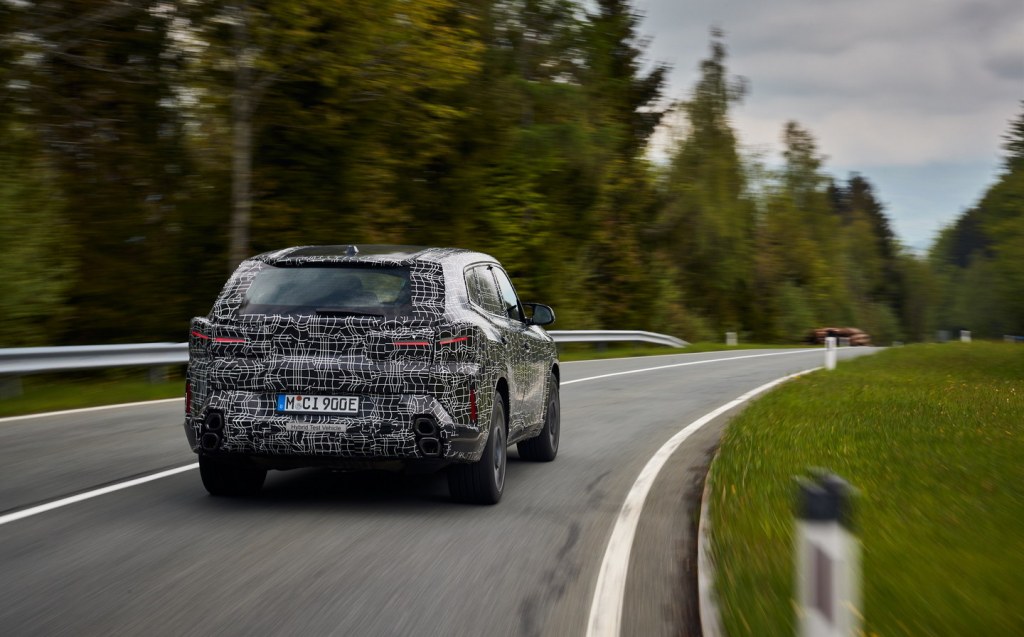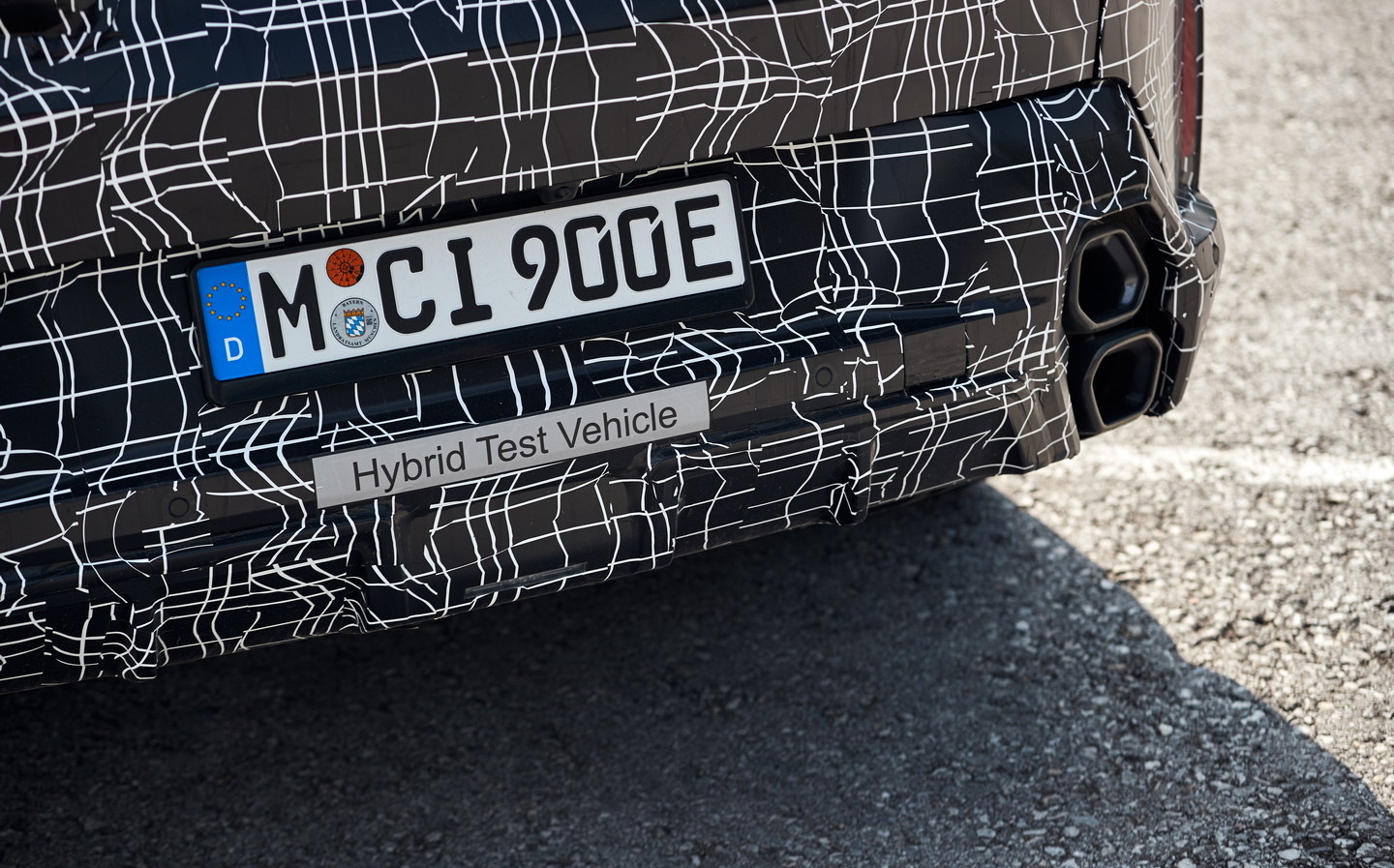BMW XM 2023 prototype review: An early drive in one of BMW M’s most controversial products yet
Maybe it should keep the disguise on
This year is the 50th anniversary of BMW M, the German car maker’s sports division, and while there’s plenty to get excited about on the traditional side of the business with the M3 Touring, M4 CSL and new M2 Coupé all set to be unveiled this year, the firm is also about to widen its remit with the introduction of its first plug-in hybrid: the BMW XM.
This huge new SUV is only the second ever standalone model from BMW M (the first was the M1 of the late 1970s). At the reveal of the concept car in late 2021, a lot of focus was on the divisively massive — and massively divisive — front grille, and that particular feature looks set to make it into production, though it’s fair to say a lot of the concept’s design elements were not universally praised.
The showroom-ready version won’t be revealed until September this year so the BMW XM Driving.co.uk was allowed to test drive was an engineering prototype, which means there was an attempt to disguise the final look of the car.
But underneath that wavy camouflage the car was close to production ready and we were allowed to put our foot down in a high-speed drive through the Austrian countryside, giving us a good idea of what the final version will feel like behind the wheel.
Can the driving experience distract from what is likely to be a contentious departure from the norm for BMW M? Read on for our early review of the 2023 BMW XM.
Exterior design

Despite our test car’s black-and-white camouflage wrap it’s clear that much of the detailing of the Concept XM will be carried over – including a massive radiator grille. Unsurprisingly, the XM will include the new split-headlight feature that has already been shown on the revised BMW X7 and all-new 7 Series.
The XM’s bonnet has a central channel housing the BMW badge and the front and rear wings look muscular even under the camouflage.
The minimum wheel size will be 22in and there will be a 23in option, too.
Meanwhile, there’s a rising window line and sloping roof to give the profile a little dynamism. Carbon-capped aerodynamic door mirrors, as found on cars such as the BMW M8, are carried over to the production version of the XM.

At the rear, BMW let us see the new ‘stacked’ take on M’s traditional quad exhaust setup, while a subtle roof spoiler is also visible.
However, the dramatically sculpted rear lights are still under wraps and it’s possible that there are M1-inspired BMW roundels etched into the rear glass hatch – as on the concept.
Interior design

Though the images of the XM’s interior don’t show a lot, we did get to see under the covers. The new curved glass dashboard layout we’ve already experience on other new BMWs is employed here, with bespoke graphics and menu items to suit the XM’s plug-in hybrid powertrain.
Other than that, the XM feels much like any of the existing M cars up front, as it uses the same shifter for the transmission and there are the usual ‘M1’ and ‘M2’ buttons sticking out of the back of the steering wheel.
The test car featured a standard thick-rimmed, perfectly circular BMW M leather steering wheel, though it’s also possible that the flat-bottomed wheel shown in the new M760e xDrive will be used in production.
The rear of the XM is notably different to that of other BMW SUVs, particularly the BMW iX, as the seating is not set up high, meaning passengers feel like they’re in a car rather than a big SUV.
There’s loads of legroom and headroom, too, while BMW’s designers have integrated the rear seat with the door cards to create a sofa-like feel. It’s not as daring looking as the cabin of the concept, but it does adopt the show car’s lounge ambience somewhat.
Technology and safety
In a bid to deliver M-worthy ride and handling characteristics, BMW has thrown its full arsenal of chassis technology at the XM.
As standard, it comes with an electric roll stabilisation system using 48-volt technology. This can, on a wheel-by-wheel basis, alter the stiffness of the anti-roll bars depending on the driving mode and road conditions. At one extreme, it can effectively decouple the anti-roll bars in the name of comfort, while at the other, it is designed to prevent body roll into and through a fast corner.

Further enhancing the cornering ability is what BMW calls Integral Active Steering. That’s rear-wheel steer in normal language, where the rear wheels pivot in the opposite direction to the fronts at lower speeds – in the name of manoeuvrability and agility – while turning in phase with the front wheels at higher speeds for greater stability in fast turns and motorway lane changes. This is the first time BMW M has paired this system with all-wheel drive.
Performance, electric range and charging times
The big news here of course is that the XM is BMW M’s first electrified model, so it’s required to have plenty of go.
Full details of the powertrain have yet to be released, but we do know that the plug-in hybrid system features BMW’s latest twin-turbocharged 4.4-litre V8 petrol engine, with its turbos in the vee, and includes a powerful electric motor.
This all drives through an M version of the usual ZF-produced eight-speed automatic gearbox to all four wheels, including an electronically-controlled rear differential.

BMW confirmed that maximum outputs of the XM’s hybrid system are 644hp and 590lb ft, though it has yet to release any performance figures.
Even in electric mode there’s great response to the accelerator. Up the ante in the settings and the engine comes alive, emitting a characterful V8 burble from the exhausts (some of that sound may be enhanced, but you won’t notice or care). Acceleration from low revs is particularly impressive and completely in keeping with the M image.
You can’t really tell that an electric motor is helping things along; it just feels like it has a thumping big engine under the bonnet. It’s safe to assume that the XM will easily hit its 155mph speed limiter, too.
The electric range of the hybrid system has been quoted as around 50 miles and the charging port for the battery is above and behind the left wheel, though no information on charging speeds is available yet.
Meanwhile, there’s a new option in the car setup menu to allow two different levels of brake energy regeneration.
Ride and handling
Sven Ritter, project lead on the BMW XM, said his team were tasked with creating a car that has the capability to be more comfortable than any other M car but still retains that characteristic M car feel.
He admitted that there were some compromises to be made in the pursuit of that goal, but it explains the presence of all the advanced chassis technology described above.
How the XM drives is dependent on the various drive settings. As in all M cars these days, there’s a setup menu accessed via a button on the centre console. Within that, the driver chooses various levels of sportiness for all the sub-systems, including engine, rear differential, damping and more.

As far as the ride goes, in the default settings the XM dispatches a potholed access road in a more comfortable manner than any other M-badged SUV would manage, though there’s clearly an inherent stiffness to the suspension that’s unavoidable.
When the dampers are in Comfort mode, the active anti-roll system is at its most relaxed as well, and the car proves to be a decent high-speed cruiser in this guise.
Despite the massive tyres, road noise isn’t awful (on smooth German asphalt in any case) and wind roar is kept at bay with double-glazed side glass, too.
The XM is especially quiet when running in electric mode. Well, it would be if the synthetic engine sound – created by movie composer Hans Zimmer – were not piped through the speakers. It sounds different to the iX and i4, and even has strange fake “throttle blips” as you slow down to a stop.
Ritter told us the Sport Plus damper mode is best kept for perfect roads, and that the middle Sport setting was used during the car’s development laps at the Nürburgring.
Selecting that doesn’t totally ruin the ride comfort, but there’s a noticeable improvement in the body control. In fact, there’s almost no lean at all, no matter how fast you barrel through a turn. Thankfully, unlike some such systems, it feels completely natural, and it allows for some quite silly cornering speeds.
For a particularly interesting sequence of tighter corners, it’s worth pairing this setting with the 4WD Sport mode. As with other all-wheel-drive M cars, this sends more of the engine output to the rear wheels more of the time, giving the sensation of driving a rear-drive car, but with added traction. It’s highly effective, and the XM is genuinely fun to push hard when the road allows.

BMW hasn’t told us how much the XM weighs, but it won’t be a small figure. Nonetheless, its chassis shrugs it off and allows the big SUV to be driven quickly in safety, with more involvement than anyone would expect from a big, weighty, plug-in hybrid SUV.
Naturally, few XM owners will take it on a racetrack, so BMW omitted the rear-drive-only setting but, in keeping with the fact that one of the XM’s biggest markets will be the Middle East, it has been replaced by a new 4WD Sand mode. This locks the rear and centre differentials for optimal traction on sand.
Pricing and on-sale date
Given that the BMW XM won’t go on sale until March 2023, it’s understandable that BMW UK has yet to confirm pricing. Going by pricing of the rest of the BMW M line-up, be prepared for a figure north of £150,000.
Verdict: BMW XM review
The XM is not a regular BMW M car. That isn’t because it’s a large SUV or because it uses plug-in hybrid power, but due to the company’s desire to widen its breadth of capability beyond anything that it has produced before.

First impressions suggest that it has managed that well, and that the target audience – primarily in the USA, China and the Middle East – will appreciate the addition of a new high-end BMW M SUV.
Whether the styling will be to everyone’s tastes remains to be seen but if it proves popular in key markets, that could be good news for the rest of us; financial success means a continuation of the core M models we’ve grown to love over the past five decades of the division.
Related articles
- After reading our review of the 2023 BMW XM, you should check out Will Dron’s review of the Aston Martin DBX707
- Like high-performance cars? Take a read of our review of the Ferrari 296 GTB
- Read Driving.co.uk’s review of the McLaren 765LT, which Will Dron reckons probably “has amphetamines licked” when it comes to thrills
Latest articles
- Aston Martin Valkyrie AMR-LMH hypercar hits track ahead of 2025 Le Mans challenge

- Porsche has begun testing the electric Cayenne

- Cupra Leon 272 eHybrid 2024 review: Bigger battery, better tech … but is it a Cupra?

- Porsche 911 GTS 2024 review: Hybrid heresy or more Stuttgart genius?

- Extended test: 2023 Vauxhall Astra Sports Tourer GS PHEV

- Ford Capri revival has faced a lot of flak… but are buyers put off? Here’s what visitors to the Festival of Speed had to say
























